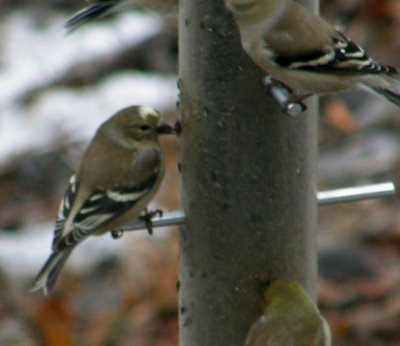Albinism is the total lack of pigment in the body. A bird will have all white feathers, pink legs and pink eyes. A leucistic bird has regular colored eyes and legs and the feathers are either paler or they have white patches. These birds with white patches are called pied or piebald. (Though it has nothing to do with leucism, this is where the term Bald Eagle comes from. It is a shorter version of Piebald Eagle in reference to the white tail and head.) The cells of a leucistic bird are damaged and cannot make the coloration necessary for the coloration of some of their feathers. Only the affected cells are white and leucism only affects feathers which is why the legs and eyes remain the correct color. In contrast, albino birds lack the pigment melanin in all of their cells so their eyes and legs are also not the normal color. Interestingly, some animals have skin pigments other than melanin so a totally leucistic individual of a species could be whiter than a true albino of the same species which might appear yellow. This is sometimes seen in lions. Ecobirder locally in the Twin Cities had some great shots of a partially leucistic Canada Goose and Female Mallard back in December.
Here's the bird I spotted at our feeders. You can see the white patch on his head.

Are these new spring feathers or old fall feathers? According to the page turner, "The Molt of the American Goldfinch" by A. L. A. Middleton, "The prenuptial (prealternate) molt was restricted to the replacement of the body feathers only, which resulted in the acquisition of the dimorphic breeding (alternate) plumage. The first signs of this molt occurred in late January when isolated pin feathers reappeared on the throat and head. This resulted in a gradual reappearance of yellow on the throat and the reappearance of the black cap in males. The number of pin feathers on the face and head increased in late February ..." (emphasis added)
This suggests that the spring molt begins on the throat and head. If you look carefully you can see a few tiny yellow feathers coming in on this bird but the white crown looks like a big patch and not random new feathers coming in. I'm going to guess these are feathers from the fall.
When I went back to the feeders a few days later I was again able to spot this same bird and another partially leucistic individual as well.
The moral of the story? Get out there and take a more careful look at your feeders. There are subtle differences in individuals that makes bird watching more interesting.
~Kirk





1 comments:
This helps as we saw a "funny looking cardinal".Brownish body,white head and orange crest. We live in Arkansas...
Post a Comment